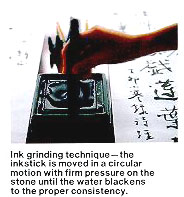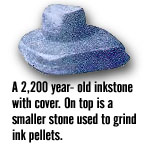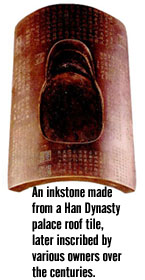Abrasive
Treasure (page 2)
Photos Courtesy of The National
Palace Mesuem
Although a small charcoal
fire could be lit under bronze and iron inkstones, preventing the ink from
freezing during cold north China winters, they also proved less than ideal
for grinding ink.
New archaeological discoveries constantly push the earliest believed
date for the use  of
inkstones further back into Chinese antiquity. In 1975, archaeologists
uncovered an inkstone from an ancient tomb in the Yunmeng (¶³¹Ú) area of
Hupeh Province. It proved to be approximately 2,200 years old, dating back
to the Ch'in Dynasty (221-206 B.C.). This particular discovery was important
because it yielded the first inkstone dated to before the Christian era.
But archaeologists were soon to move the date back much further.
of
inkstones further back into Chinese antiquity. In 1975, archaeologists
uncovered an inkstone from an ancient tomb in the Yunmeng (¶³¹Ú) area of
Hupeh Province. It proved to be approximately 2,200 years old, dating back
to the Ch'in Dynasty (221-206 B.C.). This particular discovery was important
because it yielded the first inkstone dated to before the Christian era.
But archaeologists were soon to move the date back much further.
Only five years later, a phenomenal archaeological find made international
news: the discovery of an inkstone over 5,000 years old. Excavated at the
Lintung Chiangchai Neolithic site ( Á{¼à«¸¹ë¿ò§}), just fifteen kilometers
from the famous Panp'o Neolithic site ( ¦è¦w¥b©Y¿ò§}) at Sian, Shensi Province,
it is dated to the early part of the Yangshao Neolithic pottery culture
( ¥õ»à¤å¤Æ).
Uncovered together with the inkstone were ink pellets and a ceramic
waterpot, both used with the inkstone. China did not have a written language
at that early date, but archaeologists have long believed that many of
the designs on the painted pottery from that time were done with a brush.
The excavated brush, together with the inkstone, ink, and waterpot, constitutes
a complete Neolithic painting set, and remains the earliest predecessor
of three of the scholar's "four treasures" found so far.
Despite its ancient age, the inkstone excavated from the Chiangchai
site is anything  but
primitive. It has a cover, and a depressed surface for grinding the ink.
It therefore closely resembles the inkstones familiar several millennia.
later. This early inkstone, however, like the one uncovered in Yunmeng,
was used in a somewhat different manner from later inkstones because of
the form of ink. The ink pellets found with these early stones were too
small to be held in the hand and ground like more recent inksticks. Instead,
both of these early discoveries were found with another stone shaped like
a pestle; the ink was ground by putting an ink pellet on the surface of
the larger inkstone, then the smaller pestle was used to grind the ink
pellet.
but
primitive. It has a cover, and a depressed surface for grinding the ink.
It therefore closely resembles the inkstones familiar several millennia.
later. This early inkstone, however, like the one uncovered in Yunmeng,
was used in a somewhat different manner from later inkstones because of
the form of ink. The ink pellets found with these early stones were too
small to be held in the hand and ground like more recent inksticks. Instead,
both of these early discoveries were found with another stone shaped like
a pestle; the ink was ground by putting an ink pellet on the surface of
the larger inkstone, then the smaller pestle was used to grind the ink
pellet.
Other discoveries have shown that by the advent of the Christian era
stonewas no longer used for the manufacture of inkstones. For almost a
millennium, ceramic became the material of choice. However, these inkstones
were very dif- ferent from other ceramic ware of the time. Ceramic roofing
tiles from Chinese palaces provided an unusual yet very suitable material
for making inkstones. Rectangular in shape and curved like a quarter moon,
a small ink well and water reservoir was chiseled out of the center of
the tile. For greater durability, these roof tiles were fired in kilns
at higher temperatures than ordinary ceramic ware, producing a fne, hard
surface. Ink- sticks could be easily ground on this type of inkstone, which
had the added quality of not damaging brushes or retarding the evaporation
of ground ink.


Foreword and Preface
The Brush: Unaltered Craftsmanship
The Inkstick: Black Soil
Artistry
Paper: The Basic Fiber of Communication
The Inkstone: Abrasive
Treausre
The Inkstone: Unparalleled
Connaisseur
Accessories For The Studio:
Functional Artistry
for questions and comments please send to liaoless@iii.org.tw

By Jeffrey H. Mindich
Published by the Council for Cultureal Affairs Executive Yuan Republic
of China
 of
inkstones further back into Chinese antiquity. In 1975, archaeologists
uncovered an inkstone from an ancient tomb in the Yunmeng (¶³¹Ú) area of
Hupeh Province. It proved to be approximately 2,200 years old, dating back
to the Ch'in Dynasty (221-206 B.C.). This particular discovery was important
because it yielded the first inkstone dated to before the Christian era.
But archaeologists were soon to move the date back much further.
of
inkstones further back into Chinese antiquity. In 1975, archaeologists
uncovered an inkstone from an ancient tomb in the Yunmeng (¶³¹Ú) area of
Hupeh Province. It proved to be approximately 2,200 years old, dating back
to the Ch'in Dynasty (221-206 B.C.). This particular discovery was important
because it yielded the first inkstone dated to before the Christian era.
But archaeologists were soon to move the date back much further.
 but
primitive. It has a cover, and a depressed surface for grinding the ink.
It therefore closely resembles the inkstones familiar several millennia.
later. This early inkstone, however, like the one uncovered in Yunmeng,
was used in a somewhat different manner from later inkstones because of
the form of ink. The ink pellets found with these early stones were too
small to be held in the hand and ground like more recent inksticks. Instead,
both of these early discoveries were found with another stone shaped like
a pestle; the ink was ground by putting an ink pellet on the surface of
the larger inkstone, then the smaller pestle was used to grind the ink
pellet.
but
primitive. It has a cover, and a depressed surface for grinding the ink.
It therefore closely resembles the inkstones familiar several millennia.
later. This early inkstone, however, like the one uncovered in Yunmeng,
was used in a somewhat different manner from later inkstones because of
the form of ink. The ink pellets found with these early stones were too
small to be held in the hand and ground like more recent inksticks. Instead,
both of these early discoveries were found with another stone shaped like
a pestle; the ink was ground by putting an ink pellet on the surface of
the larger inkstone, then the smaller pestle was used to grind the ink
pellet.